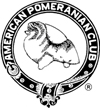Note: This is not the current version of the breed standard.
Appearance.- The Pomeranian in build and appearance should be a compact, short-coupled dog, well-knit in frame. He should exhibit great intelligence in his expression, activity and buoyancy in his deportment.
Head and Nose.- The head and nose should be foxy in outline, or wedge-shaped, the skull being slightly flat, large in proportion to the muzzle, which should finish rather fine, and be free from lippiness. The teeth should be level, and should on no account undershot. The hair on the head and face must be smooth and short-coated. The nose should be black in white, orange, and shaded-sable dogs; but in other colours may be “self-colored,” but never parti-coloured or white.
Ears.- The ears should be small, not set too far apart, nor too low down, but carried perfectly erect like those of a fox.
Eyes.- The eyes should be medium in size, not full nor set too wide apart, bright and dark in colour, showing great intelligence. In white, orange, shaded-sable, and cream dogs, the rims around the eyes should be black.
Neck and Body.- The neck should be rather short and well set in. The back must be short, and the body compact, being well ribbed up and the barrel well rounded. The chest must be fairly deep and not too wide, but in proportion to the size of the dog.
Legs.- The forelegs must be well feathered and perfectly straight, of medium length, and not such as would be termed “leggy” or “low on leg,” but in length and strength in due proportion to a well-balanced frame. The shoulders should be clean and well laid back. The hind legs and thighs must be well feathered down to the hocks, and must be neither “cow-hocked” nor wide behind. They must be fine in bone and free in action. The feet should be small and compact in shape.
Tail.- The tail is one of the characteristics of the breed, and should be turned over the back and carried flat and straight, being profusely covered with long, harsh, spreading hair.
Coat.- There should be two coats – an undercoat and an overcoat; the one a soft fluffy undercoat, the other a long perfectly straight coat, harsh in texture and covering the body, being very abundant round the neck and forepart of the shoulders and chest, where it should form a frill of profuse, standing-off, straight hair, extending over the shoulders. The hindquarters should be clad with long hair or feathering, from the top of the rump to the hocks.
Colour.- All
whole-colours are admissible, but they
should be free from white shadings. At
present the whole-coloured dogs are: –
White.
Black.
Brown, light or dark.
Blue, as pale as possible.
Orange, which should be as deep and even in
colour as possible.
Beaver.
Cream, which should have black noses and
black rims around the eyes.
Whites must be quite free from lemon or any
other colour. A few white hairs in any of
the self-colors shall not necessarily
disqualify. Dogs other than white, with
white or tan markings, are decidedly
objectionable, and should be discouraged.
They cannot compete as whole-coloured
specimens. In parti-colored dogs the colours
should be evenly distributed on the body in
patches; a dog with white or tan feet or
chest would not be a parti-coloured dog.
Shaded-sables should be shaded throughout
with three or more colours, the hair to be
as uniformly shaded as possible, and with no
patches of self-colour. In mixed classes,
where whole-coloured and parti-coloured
Pomeranians compete together, the preference
should, if in other points they are equal,
be given to the whole-coloured specimens.
Points
Appearance—————————————————-10
Head and Nose————————————————10
Ears————————————————————-5
Eyes————————————————————-5
Nose————————————————————5
Neck and Body————————————————15
Legs————————————————————10
Tail————————————————————–5
Coat————————————————————25
Colour———————————————————-15
Total——————————————————-100

